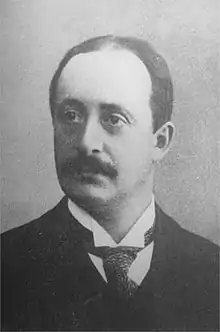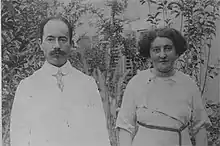Arthur Ruppin
Arthur Ruppin (1 March 1876 – 1 January 1943) was a Zionist thinker and leader. He was one of the founders of the city of Tel Aviv. He directed Berlin's Bureau for Jewish Statistics and Demography from 1902 to 1907. From 1908 on, he was the director of the Palestine Office of the Zionist Organization in Jaffa, organizing Zionist colonisation in Palestine. In 1926 Ruppin joined the faculty of the Hebrew University of Jerusalem and founded the sociology department. A building there is now named in his honor. His most celebrated sociological work is The Jews in the Modern World (1934).
Arthur Ruppin | |
|---|---|
 | |
| Born | 1 March 1876 |
| Died | 1 January 1943 (aged 66) |
| Resting place | Kibbutz Degania Alef |
Biography
Arthur Ruppin was born in Rawicz in the German Empire (today in Poland). When he was fifteen, his family's poverty forced him to work to support them. Nonetheless, he was able to complete his studies in law and economics, winning the Krupp prize in 1899 for his dissertation on the use of social Darwinism in industry. He was to distinguish himself both in furthering practical Zionist settlement and in the academic world.
Zionist activism



Ruppin joined the Zionist Organization (ZO, the future World Zionist Organization – WZO) in 1905. In 1907 he was sent by David Wolffsohn, the President of the ZO, to study the condition of the Yishuv (the Jewish community in Palestine), then in the Ottoman Empire, to investigate the possibilities for development of agriculture and industry. He reported on what he saw, which was distressing, and gave recommendations for improving the situation. In 1908 Ruppin came to live in Palestine by decision of the eighth Zionist Congress. He opened the Palestine Office of the Zionist Organization in Jaffa, with the aim of directing the settlement activities of the Zionist movement. His work made Practical Zionism possible and shaped the direction of the Second Aliya, the last wave of Jewish immigration to Palestine before World War I.
Ruppin became the chief Zionist land agent. He helped to get a loan for Ahuzat Bayit, later Tel Aviv, and acquired land on the Carmel, in Afula, in the Jezreel Valley, and in Jerusalem. Ruppin was instrumental in shaping the nature of Jewish settlement in Palestine and in changing the paradigm of settlement from those of plantation owners and poor laborers to the collective and cooperative kibbutzim and moshavim that became the backbone of the state-in-the-making. He catalyzed the commune at Sejera, and helped building the first kibbutz – Degania, as well as helping to support and organize Kinneret, Merhavia and other settlements (background about Labor Zionism can be found at www.mideastweb.org).[1] Later, he supported Yehoshua Hankin in his purchases of large tracts of land in the Galilee.
Ruppin was among the founders of the Brit Shalom peace movement, which supported a binational state, but he left Brit Shalom after the 1929 Hebron massacre. Thereafter he was convinced that only an independent Jewish state would be possible, and he believed that the way to bring about that state was through continued settlement. He headed the Jewish Agency between 1933 and 1935, and helped to settle the large numbers of Jewish immigrants from Germany who came in that period. Ruppin died in 1943. He was buried in Degania Alef.
Race theory
Ruppin considered assimilation as the worst threat to the existence of Jews as people, and argued for a concentration of Jews in a common area, to be realized by the colonisation of Palestine, where they would be protected from the assimilationist tendencies in Europe, as he explained in his book "The Jews of the Present" ("Die Juden der Gegenwart" in German), especially in its second, largely-amended, edition. Ruppin accepted the idea of a division of humankind into three important races of humans, the "white", "yellow" and "black" and considered Jews to be part of the "white" race (page 213/214), and within this "race", which Ruppin divides in "Xantrochroe" (light colored) and "Melanochroe" (dark colored), to be part of the latter, actually mixture from the Arab and North African peoples and other West and South Asian peoples.
Ruppin believed that realization of Zionism required "racial purity" of Jews and was inspired by works of anti-semitic thinkers, including some Nazis.[2] Ruppin personally met Hans F. K. Günther, one of many racist thinkers who greatly influenced Nazism.[3]
Ruppin believed in numerous "Jewish types," performed skull measurements and believed Ashkenazi Jews were made of various racial subclasses, according to nasal structure.[4] He distinguished between "Racial Jews" and "Jewish types", and believed Ashkenazi Jews to be superior to Yemeni Jews. His concepts included dividing Jews into "white, black and yellow" metaracial categories.[5]
Ruppin wrote that Jewish race should be "purified", and he stated that "only the racially pure come to the land.” After becoming head of the Palestine Office of the Zionist Executive (later the Jewish Agency for Israel), he argued against immigration of Ethiopian Jews because of their lack of "blood connection" and that Yemenite Jews should be limited to menial labor.[6] Due to the Holocaust, historiography in Israel usually played down or ignored altogether this aspect of Ruppin's life.[7]
Awards and recognition
Many cities in Israel named streets after him, and the city of Haifa has a prize in his name awarded for extraordinary works in thinking, philosophy and politics. One of the prize-winners was the philosopher, Zionist and friend of Kafka's, Felix Weltsch in 1952.
The German city Magdeburg, in which Ruppin lived during his youth, has named a street after him.
Ruppin Academic Center is named after Arthur Ruppin.
References
- "Labor Zionism & Socialist Zionism". www.mideastweb.org.
- Tom Segev, 'The Makings of History / Revisiting Arthur Ruppin,'] Haaretz8 October 2009.
- Steven E. Aschheim, Beyond the Border: The German-Jewish Legacy Abroad Princeton University Press (2007) 2018 ISBN 978-0-691-18632-0 p.125, n.19.
- The Makings of History / Revisiting Arthur Ruppin Tom Segev Haaretz
- Colonial Lives of Property: Law, Land, and Racial Regimes of Ownership Brenna Bhan Duke University Press 2018
- Israel’s Uncomfortable History of Racist Engineering Seth J. Frantzman Forward April 21, 2014
- The Makings of History / Revisiting Arthur Ruppin Tom Segev Haaretz
Further reading
- Bloom, Etan (2007). "The "Administrative Knight" – Arthur Ruppin and the Rise of Zionist Statistics". The Tel Aviv University Year Book for German History. XXXV.
- Bloom, Etan (2007). "On the German Origins of Hebrew Culture: The Repression of the Nationalist Role of Arthur Ruppin: The Father of Jewish Settlement in the land of Israel" (in Hebrew). 11. Mitaam. Cite journal requires
|journal=(help) - Bloom, Etan (2007). "What "The Father" had in Mind, Arthur Ruppin (1876–1943), Cultural Identity, Weltanschauung and Action". The Journal for History of European Ideas. 33/3.
- The Central Zionist Archives in Jerusalem: Arthur Ruppin Collections.
- Arthur Ruppin's Concept of Race Amos Morris-Reich Israel Studies Vol. 11, No. 3 (Fall, 2006), pp. 1-30 Indiana University Press
External links
![]() Media related to Arthur Ruppin at Wikimedia Commons
Media related to Arthur Ruppin at Wikimedia Commons
- The personal papers of Arthur Ruppin are kept at the Central Zionist Archives in Jerusalem. The notation of the record group is A107.
- Writings by Arthur Ruppin in the online digital collections of the Frankfurt University Library (in their original German language, and in translations)
- »Dreißig Jahre Aufbau in Palästina« collection of speeches and writings by Artur Ruppin (in German). Schocken, Berlin, 1937. Online edition at the German National Library (english version »Three decades of Palestine : speeches and papers on the upbuilding of the Jewish national home« accessible only in the library's reading room)
- »Die Juden der Gegenwart« (The Jews of the Present - German) online at Deutsche Nationalbiblithek